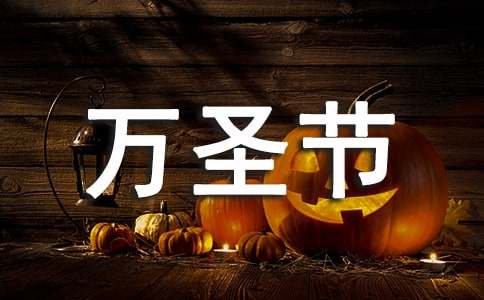有關萬圣節的英語作文2016
祝萬圣節的夜晚,大家過得失聲尖叫起雞皮,過得死人活人一起嚇一跳。以下是小編帶來的萬圣節英語作文,希望對你有幫助。

萬圣節英語作文(一)
Halloween is a spooky and scary night.People dress up in the Hallween.Some people buy pumpkin and carve it into a jack-o-lantern.A jack-o-lantern is a pumpkin with a face.This is how you make a jack-o-lantern:you buy a pumpkin,take it home,carve the pumpkin and give it a spooky,happy,scary face.
(萬圣節是一個可怕的嚇人的晚上。那一天會人們喬裝打扮。一些人把南瓜買來并刻成杰克燈。杰克燈就是一個刻著人面型的南瓜。制作杰克燈的方法:買一個南瓜,帶回家,雕刻南瓜,給它一個可怕的,嚇人的或者開心的臉)
A warty witch can fly on her fast and speeding broom in the sky.She can be wearing black pants and a black robe.If you see one ,she mignt be carrying a black cat to give bad luck.
(女巫騎著掃帚在天空中飛,她穿著黑色的褲子和長袍,如果你見到她,她帶著的黑貓會給你帶來壞運氣)
A spooky,scary,and white ghost can go through walls and could control people.You might see one in the grave yard.Be careful because it will frighten you.You might become one of them!
(一個可怕的嚇人的白色的鬼魂會飛過墻并控制住人。在墓地里你能看到他們,小心!他們會飛向你,那樣你就會變成他們中的一個!)
The black cat can give bad luck when it crosses your path.The black cat is just a cat that it is black and can give bad luck.A black cat can be in a back yard in the house,on the streets, or on a witch‘s broom.
(當黑貓經過你身邊時會給你帶來壞運氣。黑貓僅僅是一只會給人們帶來壞運氣的黑色的貓。黑貓通常呆在后院,街道上,或者在女巫的掃帚里。)
萬圣節英語作文(二)
Halloween's origins date back to the ancient Celtic festival of Samhain (pronounced sow-in).
The Celts, who lived 2,000 years ago in the area that is now Ireland, the United Kingdom, and northern France, celebrated their new year on November 1. This day marked the end of summer and the harvest and the beginning of the dark, cold winter, a time of year that was often associated with human death. Celts believed that on the night before the new year, the boundary between the worlds of the living and the dead became blurred. On the night of October 31, they celebrated Samhain, when it was believed that the ghosts of the dead returned to earth. In addition to causing trouble and damaging crops, Celts thought that the presence of the otherworldly spirits made it easier for the Druids, or Celtic priests, to make predictions about the future. For a people entirely dependent on the volatile natural world, these prophecies were an important source of comfort and direction during the long, dark winter.
To commemorate the event, Druids built huge sacred bonfires, where the people gathered to burn crops and animals as sacrifices to the Celtic deities.
During the celebration, the Celts wore costumes, typically consisting of animal heads and skins, and attempted to tell each other's fortunes. When the celebration was over, they re-lit their hearth fires, which they had extinguished earlier that evening, from the sacred bonfire to help protect them during the coming winter.
By A.D. 43, Romans had conquered the majority of Celtic territory. In the course of the four hundred years that they ruled the Celtic lands, two festivals of Roman origin were combined with the traditional Celtic celebration of Samhain.
The first was Feralia, a day in late October when the Romans traditionally commemorated the passing of the dead. The second was a day to honor Pomona, the Roman goddess of fruit and trees. The symbol of Pomona is the apple and the incorporation of this celebration into Samhain probably explains the tradition of "bobbing" for apples that is practiced today on Halloween.
By the 800s, the influence of Christianity had spread into Celtic lands. In the seventh century, Pope Boniface IV designated November 1 All Saints' Day, a time to honor saints and martyrs. It is widely believed today that the pope was attempting to replace the Celtic festival of the dead with a related, but church-sanctioned holiday. The celebration was also called All-hallows or All-hallowmas (from Middle English Alholowmesse meaning All Saints' Day) and the night before it, the night of Samhain, began to be called All-hallows Eve and, eventually, Halloween. Even later, in A.D. 1000, the church would make November 2 All Souls' Day, a day to honor the dead. It was celebrated similarly to Samhain, with big bonfires, parades, and dressing up in costumes as saints, angels, and devils. Together, the three celebrations, the eve of All Saints', All Saints', and All Souls', were called Hallowmas.
【萬圣節的英語作文】相關文章:
萬圣節英語作文:萬圣節01-30
萬圣節作文英語09-01
萬圣節英語作文07-28
萬圣節的英語作文07-30
英語作文萬圣節12-24
萬圣節英語作文09-22
英語作文萬圣節由來09-19
萬圣節優秀英語作文11-19
萬圣節英語作文例句11-19
萬圣節英語小作文09-01